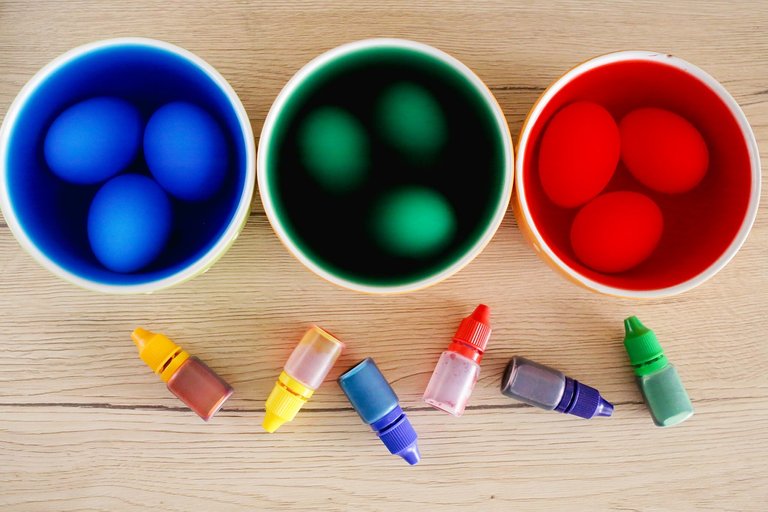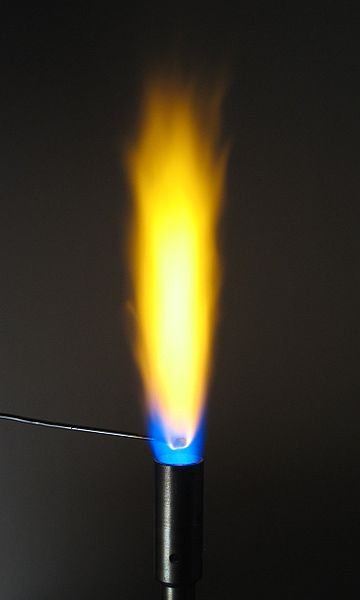The blue of denim jeans has a lasting and interesting history. Levi Strauss moved to America in 1850 during the gold rush, taking with him some heavy cotton canvas called serge de Nimes. Instead of producing tents with the canvas, he used the hard-wearing cloth to make trousers for the gold miners. This was the start of a multi million pound industry. The blue dye Levi Strauss used was indigo, which has been used as a dye for at least 3000 years. In 1860, all dyes were extracted from plants or animals, and indigo came almost exclusively from indigo bearing plants grown in huge plantations in India. The indigo market brought in 4 million pounds of revenue per annum, a fortune at that time.
 )
)Six years after Strauss dyed his first pairs of denim jeans, a chance discovery in England by William Perkin led to the world's first synthetic dye. In 1880, Adolph von Baeyer synthesized indigo, and by 1897 synthetic indigo was being manufactured. Within a few years the cultivation of natural indigo had stopped, wiping out one of India's major export industries. Indigo is a dye that fades, and during the first half of the 20th century its popularity waned as chemists synthesized new dyes that did not fade. However, in the 1960s blue denim jeans came back into fashion. The fact that synthetic indigo fades with wear became part of its attraction.
The synthesis of Indigo is a chemical success story, with chemists first determining indigo's structure and then finding ways to manufacture it much more cheaply than it could be extracted from plants.
WHY ARE THINGS COLOURED?
Colours play an enormous part in our life. Our eyes detect the colours of objects and send messages to our brain, providing us with a constant stream of information. The colour of traffic lights helps to control traffic flow and the blue flashing light of the emergency services alerts you to their presence. The colour of a food determines how appetising it appears and may indicate how fresh it is. The colours of your clothes make a statement about your personality.
 )
)Advertisers are well aware of how we are influenced by colours. They use warm colours such as orange and red to make us feel at home with a product whereas blue is a colder colour used to give the hint of sophistication. Whether we realise it or not we are much influenced every waking moment by colour.
So, basically what is colour?
We know that visible light is electromagnetic radiation with wavelengths between approximately 400 nanometer and 700 nanometer. Visible light forms a very small part of the electromagnetic spectrum. Isaac Newton, in 1666, was the first to realise that what we perceive as white light (such as sunlight) is actually made up of different colours including red, orange, yellow, green, blue and violet. These, and the range of colours in between, form the visible spectrum.
Newton passed sunlight through a prism to obtain the visible spectrum. He also demonstrated that when this spectrum of colours passed through a second prism it produced white light once more. Thomas Young and George Palmer, 150 years later, independently suggested that receptors in our eyes are sensitive to blue, green or red light and that different stimulations of these colour receptors (now called cones) enable us to perceive all the different colours. In 1861, James Clerk Maxwell, a Scottish physicist, combined beams of these three coloured lights to produce white light.
The three colours - blue, green and red - are called additive primary colours because they cannot be produced by the combination of other coloured lights. However, yellow can be made from the addition of green and red lights, cyan (a bluish green) from green and blue lights and magenta from red and blue. Yellow, cyan and magenta are called secondary colours. Colour televisions (both flat screen and older models) make use of the three additive primary colours. The screen contains millions of phosphor dots that glow either blue, red or green when activated. These dots combine to form coloured images.
The reason why the world appears so colourful is that the multitude of chemical compounds around us absorb and reflect different wavelengths from the light that falls onto them. For example, a leaf appears green because it absorbs red light and reflects light of other wavelengths. A substance that is white reflects all visible wavelengths of electromagnetic radiation. However, a substance that appears black absorbs all visible wavelengths. A substance appears coloured if it absorbs some of the electromagnetic radiation from white light, but not all of it. When a compound absorbs wavelengths of one particular colour, a complementary colour appears. Pairs of complementary colours are represented on the colour wheel below.
The coloured wavelengths that are absorbed lie opposite their complementary colour. For example, crystals of hydrated Copper (II) Sulphate appear blue because they absorb light in the orange region of the spectrum.
DYES AND PIGMENTS
Dyes and Pigments differ in one important way. Dyes are usually soluble in the medium in which they are applied while pigments are insoluble. Humans have used dyes and pigments since early times. Some cave paintings discovered in southern France and northern Spain are up to 30 000 years old. The artists of these paintings used mineral pigments to colour them. Iron (III) oxide provided the red colour, Iron (II) carbonate provided the yellow colour, while either soot or Manganese (IV) oxide were used for black. The pigments were applied to surfaces by first mixing them into a paste using mud or oil. Neanderthal tribes painted the bodies of their dead using Iron (III) oxide, also known as red ochre. The Ancient Egyptians used some chemical reactions to extend the range of pigments available. For example, red lead, Pb3O4, was produced by heating together lead and white lead, PbCO3.Pb(OH)2.
 )
) )
)Pigments are spread as a surface layer in paints, and in coloured plastic articles they are dispersed throughout the plastic. Until the 19th century nearly all pigments were inorganic. Artists’ paints used to contain lead and chromium compounds, but these are now known to pose a health hazard. They have been replaced by safer red and yellow organic pigments that can be synthesized.
In contrast to pigments, dyes are soluble. Dye molecules attach themselves to the molecules of the substance they are colouring. In some cases, dye molecules use ionic or covalent bonds, but more usually they attach themselves by hydrogen bonds or induced dipole-induced dipole forces (van der Waals forces or non-polar forces). Sometimes a fabric is first treated with a mordent, an intermediate substance that bonds to the fabric and to the dye. The mordant most commonly used in ancient times was potassium aluminium sulphate (also called potash alum), but other metal salts were also used. The metal ions bonded to the fabric and to the dye molecules through the formation of complexes. Potassium aluminium sulphate may have been the first chemical to be purified to avoid contaminants, such as Iron(III) salts, which introduced other colours into the dyeing process.
The dyeing of fabrics has a very long history and until the end of the 19th century dyes came from animals or plants. This meant that colouring clothes could be an expensive business. One of the most highly prized dyes in the days of the Roman Empire was Tyrian purple. A quarter of a million Mediterranean molluscs were required to produce just 30 g of the dye. Only members of the Emperor's family could wear togas dyed with Tyrian purple, so it became known as royal purple.
Early Britons used the woad plant, which contains the chemical indigo, to dye their clothes blue. About 30 years ago, Mexicans started to use a red dye, cochineal produced from crushing the Coccus insect. It was not until the 16th century that the Spanish brought cochineal to Europe. The production of this dye was a painstaking process that involved collecting about 150 000 insects by hand for every kilogram of dye produced.
Another red dye, alizarin, was used by the Ancient Egyptians. It came from the roots of the madder plant, which was very widely cultivated. One of the reasons why many military uniforms were red was the availability of this dye and the fact that it did not fade very quickly in sunlight.
Let’s go more into the Chemistry of Colour by discussing the Flame tests, Atomic Emission Spectroscopy and their uses.
FLAME TESTS
You have probably carried out some flame tests on inorganic compounds yourself. The presence of certain metal ions gives rise to characteristic colours. The characteristic flame colour of potassium cation is lilac, which shows that the substance being tested must contain a potassium compound. The table below gives the characteristic flame colours of some other cations:
The genesis of flame colours originated from electron transitions. The energy from the bunsen flame causes electrons in the cation to jump up to higher energy levels by absorbing amounts of energy. As they fall back down to their original energy levels they each release a certain amount of energy. If the energy corresponds to a frequency (and wavelength) in the visible spectrum, a colour is observed. You will notice from the table above that some Group 2 cations do not produce a coloured flame. Many ions do not emit light with frequencies in the visible part of the spectrum, so these do not colour the flame.
 )
) )
)When viewed through a spectroscope, the flame colour produced by a particular cation gives rise to a series of coloured lines. This series of lines is called a line emission spectrum. Other emission lines are found in other parts of the spectrum, such as the ultraviolet and infrared. A line emission spectrum is characteristic of a particular cation and can be used to identify elements in compounds, rather like fingerprints can be used to identify individuals. It is possible to determine the amount of an element present in a sample by measuring the intensities of the different emission lines in its spectrum.
If bright white light is shone onto a coloured flame and observed through a spectroscope, a series of black lines result, forming a line absorption spectrum. The metal ions in the flame remove the frequencies from the white light, which they would normally emit when excited. Taking, for instance, in the emission and absorption spectra for sodium, It is noticed that their frequencies are the same in the emission and absorption spectra because electrons absorb photons of a particular frequency when they become excited and release photons of the same frequency when they return to their ground state.
ATOMIC EMISSION SPECTROSCOPY
Atomic emission spectroscopy is used in the steel manufacturing process to determine the composition of different steels. Up to 20 elements are used in steels; the amount and presence of these elements has a profound effect on the properties of a particular steel.
 )
) )
)Atomic emission spectroscopy is also used to monitor the levels of potassium and sodium in blood. To do this for sodium the wavelength chosen is 589 nm. This is the wavelength of one of the bright yellow emission lines. The atomic emission spectrometer is then calibrated using solutions of known sodium ion concentrations. The higher the concentration, the more intense the emission line. The blood serum is then analysed and the intensity of the emission reading at 589 nm is compared with the intensities from known concentrations of sodium ions used to calibrate the instrument. This allows the concentration of sodium ions in the blood serum to be calculated.
CONCLUSION
On a final note, colour truly has a beautiful history in chemistry. Ever since the time of Levi Strauss making a fortune from his indigo-dyed denim jeans, colours have kept evolving. After the indigo dye came the synthetic dye which later turned out to be a chemical success story.
Colour plays a whole lot of significant roles in everyone's lives without which life and the entire world would have been drab, dull, and uninteresting. Imagine how life would have been for someone suffering from colour blindness.
Colours can also be traced back to the visible white lights from sunlight, all thanks to Newton, Young, Palmer and Maxwell for their great contribution to light. The world also appears so beautiful and colourful only because the chemical compounds around us absorb and reflect different wavelengths from the light that shines on them.
Finally, another importance of colour is their use in flame test to distinguish the characteristics colours of transition elements and also for detecting and measuring the level of potassium and sodium in blood.
Welcome to steemit. It's lovely to see you are already familiar with how things works here :)
Thanks, @greenrun. I've been around for a while (coming on and off) observing and learning. It's school and daily survival that keep restraining my writing here since I've registered last year. I'm quite free at least for now and I'll like to contribute to the best of my ability to the platform.
That's good to hear. Feel free to contribute to the community. Thank you.
Thanks.
This post has been voted on by the SteemSTEM curation team and voting trail. It is elligible for support from @curie.
If you appreciate the work we are doing, then consider supporting our witness stem.witness. Additional witness support to the curie witness would be appreciated as well.
For additional information please join us on the SteemSTEM discord and to get to know the rest of the community!
Thanks for having added @steemstem as a beneficiary to your post. This granted you a stronger support from SteemSTEM.
Thanks for having used the steemstem.io app. You got a stronger support!
Congratulations @empressteemah! You have completed the following achievement on the Steem blockchain and have been rewarded with new badge(s) :
You can view your badges on your Steem Board and compare to others on the Steem Ranking
If you no longer want to receive notifications, reply to this comment with the word
STOPVote for @Steemitboard as a witness to get one more award and increased upvotes!
Outstanding post! Welcome to Steemit and SteemSTEM. This is more than a post, it is a valuable resource of information to be saved and cited.
Thanks, I'm more than happy with your comment.
I thought Easter came early there for a sec :P
A nice color primer.
Lol. I like your humour.
Thanks.
What happened to your reputation?
Dunno, I guess I post rarely! It didn't go down, I think. Yours just went way up!
Congratulations @empressteemah!
Your post was mentioned in the Steem Hit Parade for newcomers in the following category:
I also upvoted your post to increase its reward
If you like my work to promote newcomers and give them more visibility on the Steem blockchain, consider to vote for my witness!